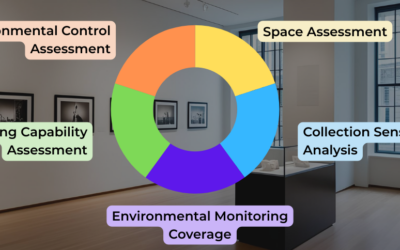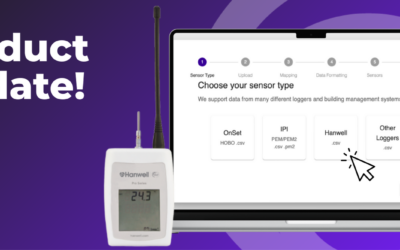As a collections care professional who, we know, is always searching for innovative solutions and ways to improve current work practices, you are keeping an eye on the latest developments in the field. So you know that data loggers with wireless capabilities have risen as invaluable tools for real-time data collection and remote monitoring. If you had the choice and no budget constraints, would you get a USB manual data logger or a real-time wireless one?
So you probably like wireless data loggers, and you might already have some, but what do you know about the network you are using? Not all wireless technologies are created equal. What do you know about WiFi, Bluetooth and LoRaWAN? If the answer is, “… I know I want them because it’s better than walking around!” you are on the right track! But if you are still at a loss at what the difference is between them, check out our other article on the characteristics of these three wireless technologies.
When it comes to data loggers, we strongly believe that LoRaWAN (Long Range Wide Area Network) stands out as a top choice. In this article, we will explore the reasons why a data logger with wireless functionality needs LoRaWAN, highlighting its unique advantages for collections care professionals.
LoRaWAN uses low-power, low-frequency radio waves to communicate over long distances. It was originally designed for the Internet of Things (IoT), which refers to the network of physical devices with sensors that can collect, process, and exchange data over a network. For our purposes, LoRaWAN connects your wireless data loggers to a gateway, which is in charge of forwarding the data to a cloud server.
1. Extended range for comprehensive coverage
One of the primary advantages of using LoRaWAN in wireless data loggers is its exceptional range. Unlike traditional Wi-Fi or Bluetooth connections, which have limited coverage areas, LoRaWAN can transmit data over long distances. This capability is especially critical for professionals responsible for overseeing extensive collections housed in multiple locations. With LoRaWAN-enabled data loggers, you can effortlessly monitor environmental conditions, such as temperature and humidity, in remote storage facilities, galleries, or even outdoor exhibition spaces.
When the Conserv team was at the AIC Conference in Los Angeles in 2022, we plugged in our gateway in the exhibit hall in the basement of the hotel and started walking to see when we lost signal. The sensor transmitted throughout the basement, the lobby, the second floor and even sections of the third floor directly above the gateway. Horizontally, it covered a full city block!
LoRaWAN’s extended range eliminates the need for frequent physical inspections. It means you don’t have to go up and down the building, cross campus or drive to your other sites to check on your data loggers all the time. Additionally, this technology ensures that data is consistently and securely transmitted, providing a comprehensive view of conditions across your entire collection.
Compared to WiFi and Bluetooth (less than 300 feet with no obstructions), LoRaWAN’s range goes up to 6 miles in rural areas and 1.8 miles in dense urban areas!
2. Low power consumption for prolonged operation
LoRaWAN data loggers excel in collections care due to their low power consumption. Because LoRaWAN transmits small packets of data, these devices can operate on a single battery for an extended period, often several years, without needing frequent replacements or recharging.
This energy-efficient feature minimizes disruptions in data collection, ensuring that you receive uninterrupted updates on your collection’s condition. It also reduces the maintenance overhead associated with replacing batteries, allowing you to focus more on your conservation efforts.
A reduced need for battery replacement means you can reap several benefits:
- Reduces or eliminates monitoring down-time.
- Reduces unsustainable battery waste and cost over time.
- Reduces the need to access the data logger to replace batteries, saving you time and reducing potential damage to nearby collections.
3. Scalability to accommodate growing collections
Collections rarely remain static; they grow and evolve over time. As a collections care professional, you need a monitoring system that can adapt to these changes seamlessly. LoRaWAN data loggers offer scalability that makes them an ideal choice for institutions with expanding collections. The Conserv gateway, for example, can take up to 1000 sensors before you need another gateway. You read that right! A thousand sensors.
You can easily integrate additional LoRaWAN-enabled sensors into your monitoring network as your collection grows. This scalability ensures that every new artifact or exhibit space is included in your data logging system without major infrastructure modifications or disruptions.
If you would like to read the technical specifications of LoRaWAN for your IT department, check out this documentation file on their website.
4. Secure and Reliable Data Transmission
Security and data integrity are paramount when monitoring and protecting valuable collections. LoRaWAN technology employs robust end-to-end encryption and authentication mechanisms, making it highly secure for transmitting sensitive data. This level of security may be overkill for simple environmental monitoring data that is not necessarily strictly confidential, but you can be sure that the information is protected regardless.
The fact that your wireless data loggers will not be directly connected to your institution’s WiFi also gives you an added layer of security as it means external agents cannot attempt to hack your systems by exploiting potential vulnerabilities in your WiFi-enabled environmental monitoring devices. This can sometimes be a barrier with your IT department, but is not a concern with LoRaWAN equipment.
Furthermore, LoRaWAN’s reliability ensures that your data loggers consistently send information to your central monitoring system. You can trust that you’ll receive alerts and updates in real-time, enabling you to respond promptly to any adverse conditions that may threaten your collection.
5. No Need to Get Your IT Team to Set You Up
Have you ever bought equipment and then had it sitting in your office for a few weeks because your IT colleagues are swamped with other tasks and can’t help you set it up yet? Implementing a new technology often requires significant IT involvement, which can be a time-consuming and resource-intensive process. However, when you opt for LoRaWAN-enabled data loggers, you’ll appreciate the simplicity of setup. These devices are designed to be user-friendly, allowing collections care professionals to install and configure them without extensive IT support. In the case of Conserv, you can just plug in the gateways, and they will start working immediately.
The straightforward setup process not only saves you time but can also empower your collections care team to take control of their monitoring systems independently. You can quickly get your monitoring network up and running, ensuring that your focus remains on the conservation and preservation of your valuable collections rather than dealing with complex IT integration. This autonomy is a valuable advantage for professionals who prefer a streamlined and efficient approach to their collections care efforts.
Conclusions
The choice of a data logger with wireless capabilities should align with your unique needs of preserving and protecting valuable artifacts and documents. LoRaWAN technology, with its extended range, low power consumption, scalability, security, and easy setup, emerges as the ideal solution for real-time data collection and remote monitoring.
By adopting LoRaWAN-enabled data loggers, you can ensure the comprehensive coverage, continuous operation, and security required to safeguard your valuable collections for future generations. Embracing this advanced technology is not just a choice; it’s a commitment to preserving our shared cultural heritage with unwavering dedication and precision.
If you have any questions about environmental monitoring, integrated pest management, or just want to talk about preventative conservation, please reach out to us! Don’t forget to check out our blog or join our community of collections care professionals where you can discuss hot topics, connect with your peers or even take a course to get familiar with the Conserv platform.




